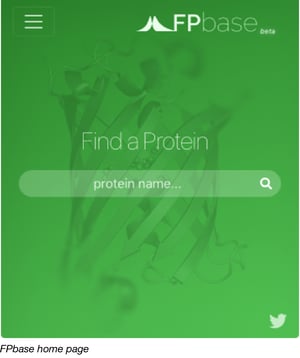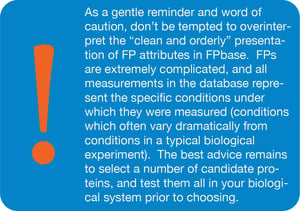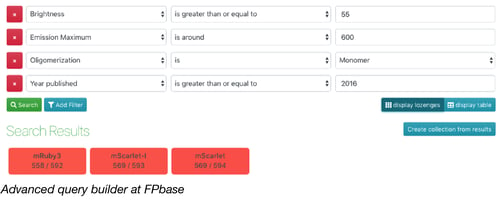This post was contributed by guest blogger Talley Lambert, a Research Associate at Harvard Medical School.
The need for a community fluorescent protein database
As recognized by the 2008 Nobel Prize, fluorescent proteins (FPs) have become one of the most indispensable tools in modern biological research. Any microscopist will tell you that selection of a fluorescent probe (be it an organic dye or FP) is one of the most important steps in the design of an imaging experiment. The choice is non-trivial, however, as FPs are tremendously complicated entities with a large range of characteristics (color, brightness, photostability, maturation, oligomerization), many of which are dramatically affected by environmental conditions (such as temperature, pH, fusion protein, etc...). There are many online guides – including an excellent series of posts by Joachim Goedhart on the Addgene blog – outlining various important considerations when choosing a FP, but much of the primary data one might require when making such a decision remains spread across literature in publications that introduce these tools.

Years ago, Kurt Thorn (UCSF at the time) began an effort to collate some of the current “best” FPs, and I collaborated with him on a web-based interactive visualization of FP attributes (which turned into www.fpvis.org). That page has been very useful over the years, and when researchers come to us for advice on choosing a protein, we often direct them there as a starting point. However, there is a great deal more information that one might like to store about FPs than is currently represented at fpvis (complete spectral information, accession numbers, sequences and lineages, FRET efficiencies, additional references, etc...) and a more robust database structure was needed. It is also difficult to scale such a resource when updates depend on a single person. With thousands of scientists routinely using and thinking about FPs, it would be great to have a centralized, community-editable resource for storage and dissemination of information about FPs.
 FPbase.org
FPbase.org
FPbase is a project written in Python & Django, using a popular database management system (PostgreSQL), that aims to eventually be a comprehensive community resource for information about fluorescent proteins. It was designed with the goal of encouraging user contributions (using simple web forms) while also maintaining a relatively strict database design (schema). Registered users can submit new fluorescent proteins, add data to existing proteins when missing, or edit inaccuracies as they find them (anyone can register with a valid email address). One may also simply attach important references that serve to further characterize a protein of interest (and we very much appreciate even those small contributions). Of course, no community-editable database is free from the risk of inaccurate data submissions, so FPbase includes a versioning system that allows users to see when a given page has unmoderated changes and to view previous versions. Currently, all submissions also require a DOI referencing primary literature, and every effort is made to moderate and cross-check all data with published literature as soon as possible after submission.
Using FPbase
The most obvious use case for FPbase is finding information on a particular FP; this can be done directly using the search bar on the homepage (and at the top of all pages). But, the whole point of a database is to browse or search information in more powerful ways, and the advanced search page simplifies the process of building advanced multi-parametric search queries. Looking for a bright, monomeric FP published in the last few years with an emission peak around 600nm? Simply input these parameters and you’ll find matching FP suggestions.
If you’re not sure exactly what you’re looking for, the Table of Fluorescent Protein Properties provides a master list of all proteins in the database, and the Interactive Fluorescent Protein Property Visualization allows for visual comparison of FPs and how they relate to one another. . In addition, the FPbase Fluorescence Spectra Viewer can be used to compare excitation and emission spectra when available, and will soon feature filter spectra and collection efficiency calculations. With ~80 FP spectra (and rapidly growing, with your help!), I believe this represents one of the largest available online collections of FP spectra.
 Every protein has a page with all the information in the database relating to that specific protein (for instance: EGFP). Users can “favorite” certain proteins, or create custom protein collections (such as a set of FPs that you or your lab use frequently) for the sake of comparison or ease of retrieval. These collection pages can be kept private, or shared publicly (so feel free to moderate your own version of fpvis.org with the proteins of your choosing!), and they can be downloaded in JSON or CSV format to quickly retrieve all of the information in the database relating to that set of proteins. For computer-savvy users looking to incorporate FPbase data in their own projects and applications, a REST API allows programmatic retrieval of the majority of information in the database.
Every protein has a page with all the information in the database relating to that specific protein (for instance: EGFP). Users can “favorite” certain proteins, or create custom protein collections (such as a set of FPs that you or your lab use frequently) for the sake of comparison or ease of retrieval. These collection pages can be kept private, or shared publicly (so feel free to moderate your own version of fpvis.org with the proteins of your choosing!), and they can be downloaded in JSON or CSV format to quickly retrieve all of the information in the database relating to that set of proteins. For computer-savvy users looking to incorporate FPbase data in their own projects and applications, a REST API allows programmatic retrieval of the majority of information in the database.
Plans for future development of FPbase
FPbase is still very much in the early stages of development, and there is plenty of room for improvement and elaboration. Current projects include incorporation of biosensors, protein evolution lineages, 2-photon spectra, more elaborate spectrum analysis tools, and a better way to store and represent within-study photobleaching comparisons. We very much appreciate feedback, so try out the site and contact us if you have any ideas or requests. Or, if you have experience in Python, fork the project on github and submit a pull request.
Many thanks to our guest blogger Talley Lambert!
 Talley Lambert is a Research Associate at Harvard Medical School. He manages the Cell Biology Microscopy Facility, specializing in advanced optical microscopy. Follow him on twitter or github @tlambert03.
Talley Lambert is a Research Associate at Harvard Medical School. He manages the Cell Biology Microscopy Facility, specializing in advanced optical microscopy. Follow him on twitter or github @tlambert03.
Additional Resources on the Addgene Blog
- Fluorescence Microscopy Techniques - Which is best for me?
- A Practical Approach to Choosing the B(right)est Fluorescent Protein
- Choosing Your Fluorescent Proteins for Multicolor Imaging
Resources on Addgene.org
- Browse all fluorescent protein plasmids
- Find plasmids for FRET
- Check out the Michael Davidson Fluorescent Protein Collection
Topics: Fluorescent Proteins, Other Fluorescent Protein Tools







Leave a Comment